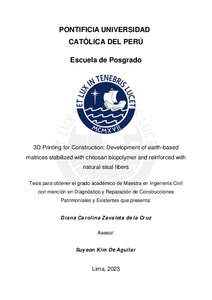| dc.contributor.advisor | Kim De Aguilar, Suyeon | |
| dc.contributor.author | Zavaleta de la Cruz, Diana Carolina | |
| dc.date.accessioned | 2024-02-05T16:04:43Z | |
| dc.date.available | 2024-02-05T16:04:43Z | |
| dc.date.created | 2023 | |
| dc.date.issued | 2024-02-05 | |
| dc.identifier.uri | http://hdl.handle.net/20.500.12404/27026 | |
| dc.description.abstract | In the last few years, 3D printing with robots or automated equipment has emerged as a
technology with significant potential in the construction sector. This approach offers several
advantages, including reduced construction time and costs, design flexibility, and the ability to
use various materials. Earth, as a building material, has gained attention in 3D printing due to
its eco-friendliness compared to cement. However, it remains relatively underexplored in this
industry. Unfortunately, earth is known for its poor mechanical strength, water durability, and
susceptibility to swelling, especially due to its clayey composition. These factors can lead to
cracking during the drying process. To address these challenges, researchers have been
investigating different materials for 3D printing, aiming to minimize the ecological footprint
by using biodegradable materials or repurposing waste for stabilization. Recent studies have
explored the use of biopolymers such as chitosan, alginate, and potato starch to enhance the
mechanical and durability properties of earth-based mixtures. Additionally, the incorporation
of natural fibers like sisal or jute has proven effective in reducing cracking in earthen structures.
Considering the above, it would be advantageous for the construction industry to employ 3D
printing to produce earth-based matrices stabilized with biopolymers and reinforced with
natural fibers. Designing such matrices requires an approach that accounts for the yield stress
suitable for 3D printing, ensuring the mixture possesses key printability characteristics such as
extrudability, workability, and buildability. The evaluation of these properties in the fresh state,
during hardening, and in the hardened state necessitates conducting various tests recommended
by international standards and researchers. In order to outline a procedure for obtaining a
printable matrix that meets the desired mechanical strength and water durability, a
methodology is proposed for developing earth-based matrices stabilized with chitosan and
reinforced with sisal fibers. This methodology consists of three stages. The first stage involves
conducting physical, mechanical, chemical, and mineralogical analyses of the raw materials:
soil, chitosan, and sisal fibers. The second stage encompasses an optimized procedure to obtain
potentially printable earth-based matrices through laboratory testing using a pastry bag. Finally,
the validated earth matrix from the previous stage undergoes 3D printing to create different
specimens, allowing for the evaluation of extrudability, pumpability, buildability, and
mechanical strength of the mixture. The printing process utilizes a motion-controlled gantry
robot with three degrees of freedom in a printing area with a volume of 1.0 m³ and employs a
progressive delivery system. | es_ES |
| dc.language.iso | eng | es_ES |
| dc.publisher | Pontificia Universidad Católica del Perú | es_ES |
| dc.rights | info:eu-repo/semantics/closedAccess | es_ES |
| dc.subject | Construcción sostenible | es_ES |
| dc.subject | Impresión tridimensional | es_ES |
| dc.subject | Biomateriales--Propiedades mecánicas | es_ES |
| dc.title | 3D printing for construction: development of earth-based matrices stabilized with chitosan biopolymer and reinforced with natural sisal fibers | es_ES |
| dc.type | info:eu-repo/semantics/masterThesis | es_ES |
| thesis.degree.name | Maestro en Ingeniería Civil con mención en Diagnóstico y Reparación de Construcciones Patrimoniales y Existentes | es_ES |
| thesis.degree.level | Maestría | es_ES |
| thesis.degree.grantor | Pontificia Universidad Católica del Perú. Escuela de Posgrado | es_ES |
| thesis.degree.discipline | Ingeniería Civil con mención en Diagnóstico y Reparación de Construcciones Patrimoniales y Existentes | es_ES |
| renati.advisor.dni | 48816908 | |
| renati.advisor.orcid | https://orcid.org/0000-0003-1621-1489 | es_ES |
| renati.author.dni | 71860416 | |
| renati.discipline | 732277 | es_ES |
| renati.juror | Nakamatsu Kuniyoshi, Javier | es_ES |
| renati.juror | Kim De Aguilar, Suyeon | es_ES |
| renati.juror | Silva Mondragon, Guido Leonardo | es_ES |
| renati.level | https://purl.org/pe-repo/renati/level#maestro | es_ES |
| renati.type | https://purl.org/pe-repo/renati/type#tesis | es_ES |
| dc.publisher.country | PE | es_ES |
| dc.subject.ocde | https://purl.org/pe-repo/ocde/ford#2.01.01 | es_ES |






